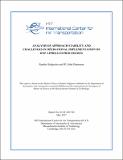Analysis of Approach Stability and Challenges in Operational Implementation of RNP Approach Procedures
Author(s)
Salgueiro, Sandro
DownloadSalgueiro-ICAT-Report.pdf (5.283Mb)
Metadata
Show full item recordAbstract
Required Navigation Performance (RNP) instrument procedures guarantee high levels of navigation precision through highly accurate navigation sources (e.g. GPS) and real-time monitoring of position estimation accuracy. In recent years, the Federal Aviation Administration (FAA) has developed and published public RNP approach procedures at airports across the country. These RNP procedures offer unique capabilities such as curved segments (radius-to-fix,
or RF legs), narrow containment areas, and constant descent profiles that are not seen combined in other categories of instrument approaches. Because of these capabilities, RNP approaches are regarded as highly flexible procedures that can be designed to meet specific stakeholder requirements (e.g. lower minimums in mountainous areas, minimizing fuel burn during approach, avoiding flight over populated areas for noise abatement, etc.) at the airport level. Among the various proposed benefits of RNP approaches, this study analyzed potential safety benefits related to improvements in approach stability. In total, 11,062 individual approaches at four airports were analyzed using radar (ASDE-X) data, of which 364 (3.29%) were identified as RNP procedures. Of all approaches analyzed, two non-RNP cases were identified as unsafe,
while there were no unsafe RNP cases. However, due to the relatively low number of RNP approaches observed, no statistically significant evidence of improved stability on RNP approaches was found. Given the low utilization of RNP approach procedures found from radar data, further work was done to identify barriers to operational use of these procedures and to investigate strategies to accelerate the adoption of RNP across the National Airspace System (NAS). Potential factors driving the low utilization of RNP procedures were found to be the low levels of equipage and operational approval among air carriers, and difficulties in air traffic management stemming from mixed equipage operations.
Date issued
2017-05-23Series/Report no.
ICAT;2017-04
Keywords
RNP, RNAV, PBN, NextGen, Approach Procedures, Navigation, Aviation Safety, Air Transportation